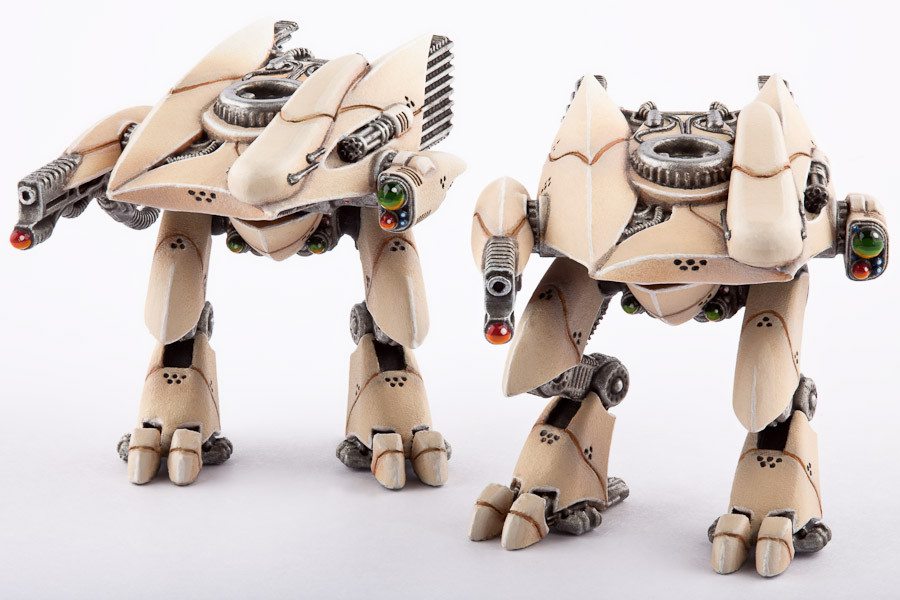TinBane is back with another great Dropzone Commander article, this time on tank tactics! For more great tactics, check out the Tactics Corner!
In nearly every game of DZC, the most important compulsory unit in terms of damage output, is going to be the main battle tank or equivalent. All four (released) races have a mandatory armoured group to go with the mandatory infantry and command at 1500pts. What do you get for your points, how useful are they, and more importantly, how are they best used?
The Contenders
The UCM Sabre relies on three things to be an effective operator. It has a powerful main gun, with a great combination of accuracy, range and energy. It has the highest possible armour in the game (10). And it has the articulation rule. In effect, the Sabre can fire from behind an object up to 1″ in height with no penalty, and is considered hull down. The major downsides to this unit are it’s dependency on good placement to make use of it’s articulation rule, and it’s low speed. If you are not bringing overwhelming force to bear on a small part of the opposing army, then you need to be holed up in cover to maximise your chances of avoiding damage.
The Hunter
The scourge don’t have the luxury of being an effective anvil unit. With only armour 8, the Hunter can’t afford to be reactive. Each anti-tank shot the enemy takes stands a very good chance of destroying a Hunter, should it connect. The Hunter’s survivability almost entirely revolves around moving the 6″ required to give opponents the +2 penalty to hit a moving skimmer. While out-ranged by all the other main battle tank equivalents, the Hunter has a few advantages of it’s own. It’s speed of 9″ means that it can close devastatingly fast, so fast you can consider fielding them without transport. While their main gun is short ranged, it packs as much punch as the PHR’s railgun technology.
The Tomahawk
On paper the Shaltari have the same gun as the UCM, which is to say equal “worst”, along with the lowest armour, without having the highest speed. The ace in the hole is their ability to teleport across the battlefield, and a passive countermeasures save (5+) which allows them the chance of bouncing nearly every weapon in the game. In general, between skimmer and their passive countermeasures, they are nearly as tough per point as the Sabre making use of it’s articulation rule. The caveat here of course, is that with only armour 7, heavy anti-air units like the Rapier are more adept at dishing out the pain. Interestingly though, they may be ideal against Scourge/Odin heavy lists where firepower is overwhelming, and the passive bounce and penalty to accuracy will hurt their enemies offensive plans.
The Ares
Perhaps one of the most maligned units in DZC at launch, the Ares was a bit of a joke. However, with the addition of a scanner rule and a points drop to 42pts it’s really come into it’s own. But exactly how well does this unit compete, especially given the amount the Shaltari and Scourge outpace it post-drop. The PHR perhaps suffer the most from the temptation for a later-game drop, but maybe that’s a result of being too greedy with Odins?
The Results
For ease of comparison, a brute force approach was used, with 10,000 samples run for every combination of attack and defender. The scale is one where 100% represents the best performing unit per point of cost, weighted by the product of points and probabilities of the targets/damage source. For the Ares, when it is the target partial damage was considered worth 14pts (1/3rd value) but defense the value of the Ares doesn’t consider damage to have any value if it doesn’t knock it out. No weighting was given to speed/range combinations.
The Sabre: Attack – 68%, Defense – 31%, Defense (Articulated) – 37%
The Hunter: Attack – 100%, Defense – 30%
The Tomahawk: Attack – 66%, Defense – 35%
The Ares: Attack – 94%, Defense – 100%
The results display the massive benefit the PHR has in a “fair” fight. On a per-point basis the Ares (with it’s new scanner rules) has 94% of the efficiency of the Hunter. That’s on a PER POINT basis, which means it’s high cost is already factored. And on a per point basis the rest of the field have a staggering 1/3 the survivability (even factoring in damage at a “value” of on third of a kill, the PHR would still be sitting on double the survivability).
What does this mean? An Ares spam list, that simply maxed out Ares as the alpha strike, would still have most of the hitting power of the dreaded hunter rush. So why isn’t it that scary? In other wargames, a statistical disparity of this magnitude would make the game unplayable, or at least, unwinnable.
In Dropzone Commander, it simply forces you to focus on the objectives. If anything, the PHR are the stereotypical “Big Bag” from TV or movies, in terms of their in-game effect. You are competing with an opponent you can’t hope to fight evenly, so you simply have to buckle up and pull the objectives effectively. It also highlights just how much benefit the PHR gain from “kill point” objectives, especially given many PHR players consider the new, improved, cheaper Ares still inferior to the Odin. Perhaps that will be the subject of my next post. Is the Odin better than the Ares mk 2, or is this an example of “internet wisdom” that no longer matches the reality of the game?
EDIT: This article was authored before the release of the new “standard” tanks. I’ll post an updated version in time, perhaps with improved stats and the new units included. Hopefully also some analysis of their movement capabilities.

